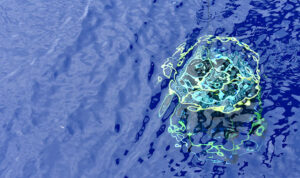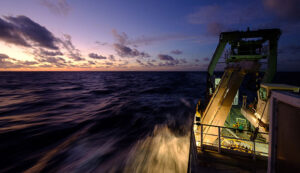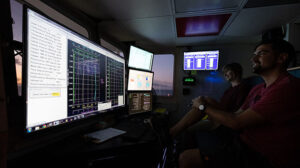An Ocean Sciences Icon Turns 30

Scientists working at the BATS site, established in 1988, have long relied on a tool that they raise and lower in the water column called a CTD, an acronym for conductivity, temperature, and depth. The CTD includes probes attached to a large metal rosette wheel that determine essential physical properties of seawater. These measurements give scientists a precise and comprehensive charting of the distribution and variation of water temperature, salinity, and density. This information helps them to understand how the oceans affect life. Photo by Annaliese Meyer.
Three decades ago, scientists came to Bermuda to address “big picture” questions about the ocean by collecting data on fundamental physical, chemical, and biological parameters throughout the water column in the Sargasso Sea. They knew that critical questions about how the ocean functions, such as how it responds to global climate change, could only be answered by the collection and subsequent analysis of data gathered continuously over a long period, also known as a time-series study.
This fall, those scientists marked 30 years of the Bermuda Atlantic Time-series Study (BATS), which they established in 1988. Since the inception of the time-series, the growing body of data collected over time has provided an unparalleled opportunity to explore, test, and answer longstanding and newly emergent oceanographic hypotheses and questions by researchers at BIOS, and those around the globe, and to integrate new methodologies into their research.

Oceanographers travel to the BATS site, nearly 50 miles (80 kilometers) off Bermuda, using the BIOS-operated vessel Atlantic Explorer. Scientists began research in this area 30 years ago. Photo by Shea Wyatt.
“It is hard to believe that BATS has run for 30 years,” said professor Nick Bates, who started working with BATS in 1991 as a doctoral student. He has since become increasingly involved with the project, eventually taking on major responsibilities as a principal investigator with physical oceanographer Rod Johnson, a fellow faculty member at BIOS, who began the project in October 1988.
“The success of the BATS project, its global significance, and our ability to observe the ocean with such care, owes a great debt to Rod, and other dedicated scientists,” including Tony Knap (a former BIOS president and director), Dennis Hansell (a professor and biogeochemist at the University of Miami), Craig Carlson (a professor and microbial oceanographer at the University of California, Santa Barbara), Debbie Steinberg (a professor and biologist at the Virginia Institute of Marine Science), Mike Lomas (a senior research scientist and marine biogeochemist at the Bigelow Laboratory for Ocean Sciences in Maine) and Tony Michaels (co-founder and managing director of Proteus Environmental Technologies in California), as well as 60 or more additional research technicians and specialists, Bates said. “They have given, and continue to give, much effort and dedication to BATS and, for many, this represents a substantial part of their lives.”
Though some technologies have advanced and evolved, such as the inclusion of gliders and underwater vehicles at and near the BATS site, the basic rhythm of their work and core operations have remained the same. Oceanographers travel to the BATS site, nearly 50 miles (80 kilometers) off Bermuda, using the BIOS-operated vessel Atlantic Explorer, and, once there, lower a shipboard CTD (conductivity, temperature, and depth) instrument.

BIOS research technician Quinn Montgomery (right) and University of Victoria student Annaliese Meyer watch real-time oceanographic data stream in during a late summer trip to the BATS site on the BIOS research vessel Atlantic Explorer. Photo by Shea Wyatt.
This approach to conducting science is the primary method of determining essential physical properties of seawater at a variety of depths, and gives scientists a precise and comprehensive charting of the distribution and variation of water temperature, salinity, and density that helps them understand how the ocean affects life.
Scientific colleagues and students from around the world also join monthly BATS cruises to undertake associated research, and many use BATS data to investigate a variety of topics, including ocean physics and biogeochemistry, the global carbon cycle, and the ocean’s response to climate change.
“The global scientific impact and influence of BATS is profound, with more than 700 research papers published through broad, direct, and indirect scientific involvement with the BATS program and its ongoing, collaborative research projects,” Bates said.

The shipboard CTD is the primary tool for determining essential physical properties of seawater at a variety of depths. A standard CTD cast, depending on water depth, requires two to five hours to complete a set of data. Water sampling is often done at specific depths so that scientists can learn the physical properties of the water column at that particular place and time. Photo by Shea Wyatt.
“Hundreds of research collaborators across the globe, BIOS support staff, and the thousands of friends of BATS, including students, researchers, policymakers who value use of BATS data and the understanding of the ocean gleaned from such observations, have made the BATS project the success it is,” he said.
In May, the National Science Foundation granted funds that will allow scientists to continue their research at the BATS site through 2023. “The project will continue to shed light on the intricacies of how the ocean functions, especially in the era of the environmental challenges we face as a global community,” Bates said.
